Accommodation · Asia · Attractions · Going Out · Hotels · Indonesia · Regions · Vacation Rentals
Joglos in the jungle: Indonesias best kept secret
I sit, poolside, high above the stupas and spiraling towers of Borobudur, set back on the dense, lush hillside, of this Javanese valley. Framed by volcanoes, distant mist, and undulating paddy fields: calm and spiritual silence descends. Weve arrived, via Jakarta, to a place rich in history, drop-dead smoldering beauty and untold promise. And this is the valley below the Menoreh Mountains; famed for Borobudur, the largest Buddhist monument in the world, which has put this sleepy community firmly, and perhaps disingenuously on a global map.
 This is Indonesias Middle Earth: mid-Java, away from the buxom, brash of Bali, far from the seductive and fertile Sumatra, and the headline hits of Komodo, Rinca and Flores. Java is often overlooked. And perhaps not surprisingly so: its capital city is rather bad PR.
Borobudur: the attraction, the region, the cultural tick box is, to many, a passing stop. The majority day-trip out to the temple for the day from nearby Yogyakarta. The site has become a mere hop, skip and a jump from Jakarta, onto Mount Bromo and out towards Indonesias islands.
This is Indonesias Middle Earth: mid-Java, away from the buxom, brash of Bali, far from the seductive and fertile Sumatra, and the headline hits of Komodo, Rinca and Flores. Java is often overlooked. And perhaps not surprisingly so: its capital city is rather bad PR.
Borobudur: the attraction, the region, the cultural tick box is, to many, a passing stop. The majority day-trip out to the temple for the day from nearby Yogyakarta. The site has become a mere hop, skip and a jump from Jakarta, onto Mount Bromo and out towards Indonesias islands.
 Im not complaining. I have been guilty of whistling through this part of town, on a longer stint in Indonesia back in 2006. Back then for us, road-weary backpackers, Borobudur was a convenient, albeit magnificent, break on the long slog to Bali. Tired and grubby, we checked into the arts scene in Yogy, enjoyed the towns bohemian vibe, and took the 30 minute bus out to the temple for a few memorable sunset hours. Tick.
This time, things felt rather different. Whilst nearby Yogyakarta has exploded with industry, Borobudur remains very local, quiet, understated. There is little of the Siem Reap about it. Yes the temple remains majestic, but the true stars of the weekend were the paddy fields, the hidden temples, the side-markets and the mosques. This humble part of the world deserves so much more than a fleeting glance from a window.
Im not complaining. I have been guilty of whistling through this part of town, on a longer stint in Indonesia back in 2006. Back then for us, road-weary backpackers, Borobudur was a convenient, albeit magnificent, break on the long slog to Bali. Tired and grubby, we checked into the arts scene in Yogy, enjoyed the towns bohemian vibe, and took the 30 minute bus out to the temple for a few memorable sunset hours. Tick.
This time, things felt rather different. Whilst nearby Yogyakarta has exploded with industry, Borobudur remains very local, quiet, understated. There is little of the Siem Reap about it. Yes the temple remains majestic, but the true stars of the weekend were the paddy fields, the hidden temples, the side-markets and the mosques. This humble part of the world deserves so much more than a fleeting glance from a window.
 And it is here, in Borobudurs jungle, where a Dutch couple have embarked on a noble and rather staggering, eco-tourism venture. Capitalising on the abundance of wow-factor in this area, the draw of Borobudur, and the paucity of boutique hideaways, the Haitsmas are in the process of developing a hamlet of hillside abodes for discerning travellers. Local artifice is framed by the high, clear, and uninterrupted view out over the region.
And it is here, in Borobudurs jungle, where a Dutch couple have embarked on a noble and rather staggering, eco-tourism venture. Capitalising on the abundance of wow-factor in this area, the draw of Borobudur, and the paucity of boutique hideaways, the Haitsmas are in the process of developing a hamlet of hillside abodes for discerning travellers. Local artifice is framed by the high, clear, and uninterrupted view out over the region.
 Villa Borobudur, the hotel complex of the collection, was to be our base for the next two days and nights. Our jaws were rather agape on arrival. Our behemoth, teak joglo for the weekend (one of only five bedroom suites) was enormous, and resplendent with locally produced hand-carved wooden fretwork, dominating the interior and exterior. Water flowed through the mouth of a ferocious red dragon in our shower room. Trinkets and boxes, inside which our clothes were carefully folded, lay by the bedside. With no glass in the windows, our room faced out over the hillside, framed by delicate carvings and climbing vines. Birds chattered in the flowers outside.
Villa Borobudur, the hotel complex of the collection, was to be our base for the next two days and nights. Our jaws were rather agape on arrival. Our behemoth, teak joglo for the weekend (one of only five bedroom suites) was enormous, and resplendent with locally produced hand-carved wooden fretwork, dominating the interior and exterior. Water flowed through the mouth of a ferocious red dragon in our shower room. Trinkets and boxes, inside which our clothes were carefully folded, lay by the bedside. With no glass in the windows, our room faced out over the hillside, framed by delicate carvings and climbing vines. Birds chattered in the flowers outside.
 The peace was startling, at first.
Meals are provided each day in the communal joglos, and out on the terracotta-tiled terraces overlooking the valley and out towards the enigmatic (and active) volcano, Mount Sumping. We breakfasted on fresh fruit and pancakes, lunched on Indonesian salads and broths, and dined on fish, curries and delicious brown rice. G+Ts, and bottles of red wine can be rustled up for you, on request.
An infinity pool lies hidden in the grounds, surrounded by trees and the flora and fauna of the hillside, again all looking up and out over the fields and temples below. For better, or for worse, the daily call of the local mosques fills the skies (five times a day), creating atmosphere, drama, and a few raised eyebrows circa 4am. Complimentary ear-plugs lie coquettishly by the bedside.
The peace was startling, at first.
Meals are provided each day in the communal joglos, and out on the terracotta-tiled terraces overlooking the valley and out towards the enigmatic (and active) volcano, Mount Sumping. We breakfasted on fresh fruit and pancakes, lunched on Indonesian salads and broths, and dined on fish, curries and delicious brown rice. G+Ts, and bottles of red wine can be rustled up for you, on request.
An infinity pool lies hidden in the grounds, surrounded by trees and the flora and fauna of the hillside, again all looking up and out over the fields and temples below. For better, or for worse, the daily call of the local mosques fills the skies (five times a day), creating atmosphere, drama, and a few raised eyebrows circa 4am. Complimentary ear-plugs lie coquettishly by the bedside.
 The Villas staff all hail from the nearby villages. Eager to please, their pride in their positions, the organization and their opportunities was palpable. Charming, and understated, the staff are a credit to the Haitsmas and their operations. This is a syncretistic operation, and the desire of all stakeholders to work together and celebrate their region was infectious.
Amanjiwo, the other luxury resort here in Borobudur, is something of a different beast. All very lovely, but not very real. The Villa Borobudur team look set to change the face of tourism in the region, becoming entwined in the fabric of their community. There is a real sense of soul and purpose here, with the keen desire to sympathetically celebrate the region, amidst the increasing onslaught of international travellers. As we drove out one day, all of the staff were gathered at the managers house adjacent to the various complexes. Smiles, clapping and laughter followed us down the drive-way.
We would spend the weekend: cycling around the local villages, and markets. We scrambled through ferns and palms, past pigeon races, school children, goats and pottery wheels; relaxing by the villas infinity pool; and being pummeled by the talented local masseurs. On Sunday evening we climbed the winding track up to a smaller, lesser-known temple, up through mountainside farming terraces, in the shadow of volcanoes, and in the company of local farmers bedding down for the night.
And of course, come sunrise on Monday morning, we were sitting amongst Borobudurs stupas and Buddhas watching the sun break over the valley.
This was a very special weekend.
The villas
At present, three villa complexes are available for guests, with a fourth high above the existing villas, is in the final stages of construction.
The Villas staff all hail from the nearby villages. Eager to please, their pride in their positions, the organization and their opportunities was palpable. Charming, and understated, the staff are a credit to the Haitsmas and their operations. This is a syncretistic operation, and the desire of all stakeholders to work together and celebrate their region was infectious.
Amanjiwo, the other luxury resort here in Borobudur, is something of a different beast. All very lovely, but not very real. The Villa Borobudur team look set to change the face of tourism in the region, becoming entwined in the fabric of their community. There is a real sense of soul and purpose here, with the keen desire to sympathetically celebrate the region, amidst the increasing onslaught of international travellers. As we drove out one day, all of the staff were gathered at the managers house adjacent to the various complexes. Smiles, clapping and laughter followed us down the drive-way.
We would spend the weekend: cycling around the local villages, and markets. We scrambled through ferns and palms, past pigeon races, school children, goats and pottery wheels; relaxing by the villas infinity pool; and being pummeled by the talented local masseurs. On Sunday evening we climbed the winding track up to a smaller, lesser-known temple, up through mountainside farming terraces, in the shadow of volcanoes, and in the company of local farmers bedding down for the night.
And of course, come sunrise on Monday morning, we were sitting amongst Borobudurs stupas and Buddhas watching the sun break over the valley.
This was a very special weekend.
The villas
At present, three villa complexes are available for guests, with a fourth high above the existing villas, is in the final stages of construction.
 Each complex is rich in Javanese heritage, yet each has its own distinct benefits:
Villa Borobudur, is made up of 7 joglos, hosting communal spaces, five bedroom suites, and a swimming pool. This is the place for independent travellers, looking for quiet up in the hills.
Villa Diponegoro, is a private villa, for a couple or small family. The nearby hotel staff are on call to look after you throughout your stay, and meals are included in the rack-rates. With a private pool, and a more secluded setting this is something of a romantic, exclusive, idyll.
Villa Merapi, the jungle complex is set back into the trees, where a series of interlocking bungalows (akin to tree-houses) interlink by a series of ladders and passageways. Perfect for large groups with active children, a swimming pool, large communal restaurant. This is a brilliant spot for an adventure.
Rates start from US$300 per night, inclusive of accommodation, meals, and WiFi.
Each complex is rich in Javanese heritage, yet each has its own distinct benefits:
Villa Borobudur, is made up of 7 joglos, hosting communal spaces, five bedroom suites, and a swimming pool. This is the place for independent travellers, looking for quiet up in the hills.
Villa Diponegoro, is a private villa, for a couple or small family. The nearby hotel staff are on call to look after you throughout your stay, and meals are included in the rack-rates. With a private pool, and a more secluded setting this is something of a romantic, exclusive, idyll.
Villa Merapi, the jungle complex is set back into the trees, where a series of interlocking bungalows (akin to tree-houses) interlink by a series of ladders and passageways. Perfect for large groups with active children, a swimming pool, large communal restaurant. This is a brilliant spot for an adventure.
Rates start from US$300 per night, inclusive of accommodation, meals, and WiFi.
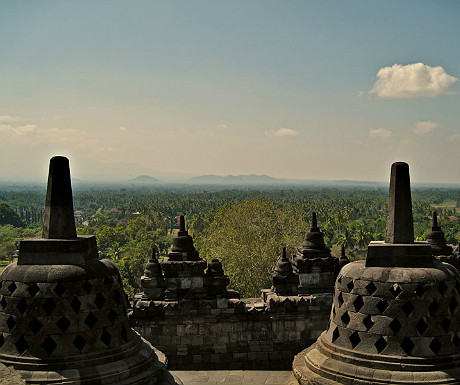 This is Indonesias Middle Earth: mid-Java, away from the buxom, brash of Bali, far from the seductive and fertile Sumatra, and the headline hits of Komodo, Rinca and Flores. Java is often overlooked. And perhaps not surprisingly so: its capital city is rather bad PR.
Borobudur: the attraction, the region, the cultural tick box is, to many, a passing stop. The majority day-trip out to the temple for the day from nearby Yogyakarta. The site has become a mere hop, skip and a jump from Jakarta, onto Mount Bromo and out towards Indonesias islands.
This is Indonesias Middle Earth: mid-Java, away from the buxom, brash of Bali, far from the seductive and fertile Sumatra, and the headline hits of Komodo, Rinca and Flores. Java is often overlooked. And perhaps not surprisingly so: its capital city is rather bad PR.
Borobudur: the attraction, the region, the cultural tick box is, to many, a passing stop. The majority day-trip out to the temple for the day from nearby Yogyakarta. The site has become a mere hop, skip and a jump from Jakarta, onto Mount Bromo and out towards Indonesias islands.
 Im not complaining. I have been guilty of whistling through this part of town, on a longer stint in Indonesia back in 2006. Back then for us, road-weary backpackers, Borobudur was a convenient, albeit magnificent, break on the long slog to Bali. Tired and grubby, we checked into the arts scene in Yogy, enjoyed the towns bohemian vibe, and took the 30 minute bus out to the temple for a few memorable sunset hours. Tick.
This time, things felt rather different. Whilst nearby Yogyakarta has exploded with industry, Borobudur remains very local, quiet, understated. There is little of the Siem Reap about it. Yes the temple remains majestic, but the true stars of the weekend were the paddy fields, the hidden temples, the side-markets and the mosques. This humble part of the world deserves so much more than a fleeting glance from a window.
Im not complaining. I have been guilty of whistling through this part of town, on a longer stint in Indonesia back in 2006. Back then for us, road-weary backpackers, Borobudur was a convenient, albeit magnificent, break on the long slog to Bali. Tired and grubby, we checked into the arts scene in Yogy, enjoyed the towns bohemian vibe, and took the 30 minute bus out to the temple for a few memorable sunset hours. Tick.
This time, things felt rather different. Whilst nearby Yogyakarta has exploded with industry, Borobudur remains very local, quiet, understated. There is little of the Siem Reap about it. Yes the temple remains majestic, but the true stars of the weekend were the paddy fields, the hidden temples, the side-markets and the mosques. This humble part of the world deserves so much more than a fleeting glance from a window.
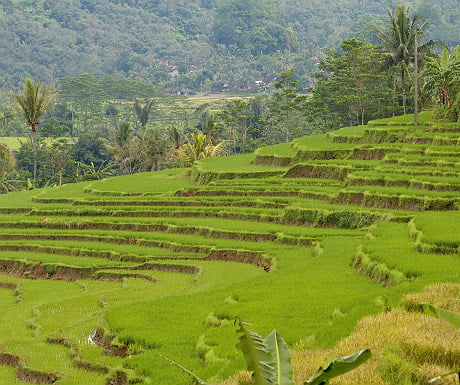 And it is here, in Borobudurs jungle, where a Dutch couple have embarked on a noble and rather staggering, eco-tourism venture. Capitalising on the abundance of wow-factor in this area, the draw of Borobudur, and the paucity of boutique hideaways, the Haitsmas are in the process of developing a hamlet of hillside abodes for discerning travellers. Local artifice is framed by the high, clear, and uninterrupted view out over the region.
And it is here, in Borobudurs jungle, where a Dutch couple have embarked on a noble and rather staggering, eco-tourism venture. Capitalising on the abundance of wow-factor in this area, the draw of Borobudur, and the paucity of boutique hideaways, the Haitsmas are in the process of developing a hamlet of hillside abodes for discerning travellers. Local artifice is framed by the high, clear, and uninterrupted view out over the region.
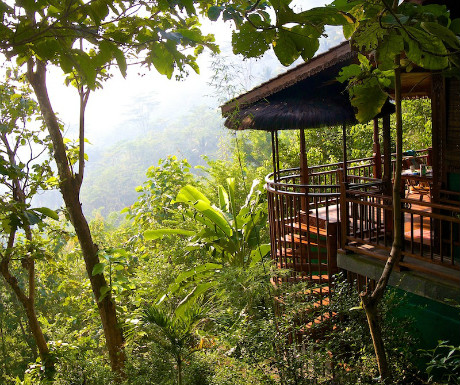 Villa Borobudur, the hotel complex of the collection, was to be our base for the next two days and nights. Our jaws were rather agape on arrival. Our behemoth, teak joglo for the weekend (one of only five bedroom suites) was enormous, and resplendent with locally produced hand-carved wooden fretwork, dominating the interior and exterior. Water flowed through the mouth of a ferocious red dragon in our shower room. Trinkets and boxes, inside which our clothes were carefully folded, lay by the bedside. With no glass in the windows, our room faced out over the hillside, framed by delicate carvings and climbing vines. Birds chattered in the flowers outside.
Villa Borobudur, the hotel complex of the collection, was to be our base for the next two days and nights. Our jaws were rather agape on arrival. Our behemoth, teak joglo for the weekend (one of only five bedroom suites) was enormous, and resplendent with locally produced hand-carved wooden fretwork, dominating the interior and exterior. Water flowed through the mouth of a ferocious red dragon in our shower room. Trinkets and boxes, inside which our clothes were carefully folded, lay by the bedside. With no glass in the windows, our room faced out over the hillside, framed by delicate carvings and climbing vines. Birds chattered in the flowers outside.
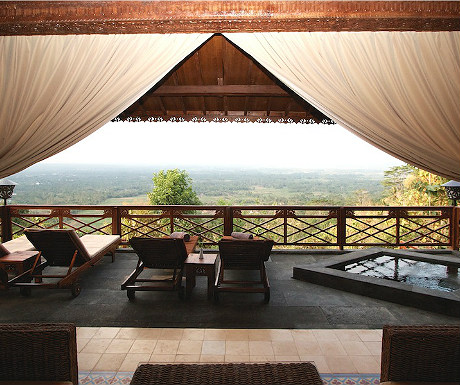 The peace was startling, at first.
Meals are provided each day in the communal joglos, and out on the terracotta-tiled terraces overlooking the valley and out towards the enigmatic (and active) volcano, Mount Sumping. We breakfasted on fresh fruit and pancakes, lunched on Indonesian salads and broths, and dined on fish, curries and delicious brown rice. G+Ts, and bottles of red wine can be rustled up for you, on request.
An infinity pool lies hidden in the grounds, surrounded by trees and the flora and fauna of the hillside, again all looking up and out over the fields and temples below. For better, or for worse, the daily call of the local mosques fills the skies (five times a day), creating atmosphere, drama, and a few raised eyebrows circa 4am. Complimentary ear-plugs lie coquettishly by the bedside.
The peace was startling, at first.
Meals are provided each day in the communal joglos, and out on the terracotta-tiled terraces overlooking the valley and out towards the enigmatic (and active) volcano, Mount Sumping. We breakfasted on fresh fruit and pancakes, lunched on Indonesian salads and broths, and dined on fish, curries and delicious brown rice. G+Ts, and bottles of red wine can be rustled up for you, on request.
An infinity pool lies hidden in the grounds, surrounded by trees and the flora and fauna of the hillside, again all looking up and out over the fields and temples below. For better, or for worse, the daily call of the local mosques fills the skies (five times a day), creating atmosphere, drama, and a few raised eyebrows circa 4am. Complimentary ear-plugs lie coquettishly by the bedside.
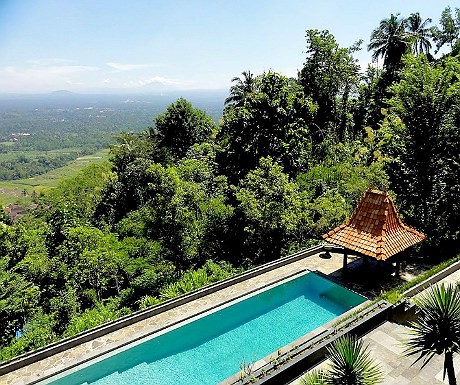 The Villas staff all hail from the nearby villages. Eager to please, their pride in their positions, the organization and their opportunities was palpable. Charming, and understated, the staff are a credit to the Haitsmas and their operations. This is a syncretistic operation, and the desire of all stakeholders to work together and celebrate their region was infectious.
Amanjiwo, the other luxury resort here in Borobudur, is something of a different beast. All very lovely, but not very real. The Villa Borobudur team look set to change the face of tourism in the region, becoming entwined in the fabric of their community. There is a real sense of soul and purpose here, with the keen desire to sympathetically celebrate the region, amidst the increasing onslaught of international travellers. As we drove out one day, all of the staff were gathered at the managers house adjacent to the various complexes. Smiles, clapping and laughter followed us down the drive-way.
We would spend the weekend: cycling around the local villages, and markets. We scrambled through ferns and palms, past pigeon races, school children, goats and pottery wheels; relaxing by the villas infinity pool; and being pummeled by the talented local masseurs. On Sunday evening we climbed the winding track up to a smaller, lesser-known temple, up through mountainside farming terraces, in the shadow of volcanoes, and in the company of local farmers bedding down for the night.
And of course, come sunrise on Monday morning, we were sitting amongst Borobudurs stupas and Buddhas watching the sun break over the valley.
This was a very special weekend.
The villas
At present, three villa complexes are available for guests, with a fourth high above the existing villas, is in the final stages of construction.
The Villas staff all hail from the nearby villages. Eager to please, their pride in their positions, the organization and their opportunities was palpable. Charming, and understated, the staff are a credit to the Haitsmas and their operations. This is a syncretistic operation, and the desire of all stakeholders to work together and celebrate their region was infectious.
Amanjiwo, the other luxury resort here in Borobudur, is something of a different beast. All very lovely, but not very real. The Villa Borobudur team look set to change the face of tourism in the region, becoming entwined in the fabric of their community. There is a real sense of soul and purpose here, with the keen desire to sympathetically celebrate the region, amidst the increasing onslaught of international travellers. As we drove out one day, all of the staff were gathered at the managers house adjacent to the various complexes. Smiles, clapping and laughter followed us down the drive-way.
We would spend the weekend: cycling around the local villages, and markets. We scrambled through ferns and palms, past pigeon races, school children, goats and pottery wheels; relaxing by the villas infinity pool; and being pummeled by the talented local masseurs. On Sunday evening we climbed the winding track up to a smaller, lesser-known temple, up through mountainside farming terraces, in the shadow of volcanoes, and in the company of local farmers bedding down for the night.
And of course, come sunrise on Monday morning, we were sitting amongst Borobudurs stupas and Buddhas watching the sun break over the valley.
This was a very special weekend.
The villas
At present, three villa complexes are available for guests, with a fourth high above the existing villas, is in the final stages of construction.
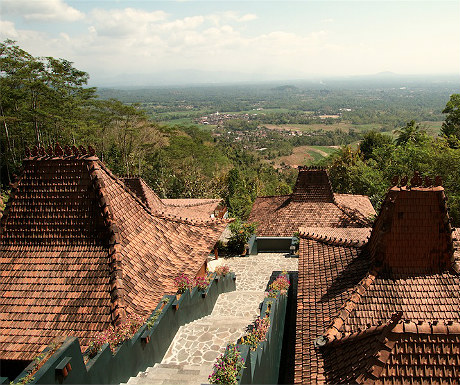 Each complex is rich in Javanese heritage, yet each has its own distinct benefits:
Villa Borobudur, is made up of 7 joglos, hosting communal spaces, five bedroom suites, and a swimming pool. This is the place for independent travellers, looking for quiet up in the hills.
Villa Diponegoro, is a private villa, for a couple or small family. The nearby hotel staff are on call to look after you throughout your stay, and meals are included in the rack-rates. With a private pool, and a more secluded setting this is something of a romantic, exclusive, idyll.
Villa Merapi, the jungle complex is set back into the trees, where a series of interlocking bungalows (akin to tree-houses) interlink by a series of ladders and passageways. Perfect for large groups with active children, a swimming pool, large communal restaurant. This is a brilliant spot for an adventure.
Rates start from US$300 per night, inclusive of accommodation, meals, and WiFi.
Each complex is rich in Javanese heritage, yet each has its own distinct benefits:
Villa Borobudur, is made up of 7 joglos, hosting communal spaces, five bedroom suites, and a swimming pool. This is the place for independent travellers, looking for quiet up in the hills.
Villa Diponegoro, is a private villa, for a couple or small family. The nearby hotel staff are on call to look after you throughout your stay, and meals are included in the rack-rates. With a private pool, and a more secluded setting this is something of a romantic, exclusive, idyll.
Villa Merapi, the jungle complex is set back into the trees, where a series of interlocking bungalows (akin to tree-houses) interlink by a series of ladders and passageways. Perfect for large groups with active children, a swimming pool, large communal restaurant. This is a brilliant spot for an adventure.
Rates start from US$300 per night, inclusive of accommodation, meals, and WiFi.Did you enjoy this article?
Receive similar content direct to your inbox.


I have never been in Indonesia, so wonderful, amazing place of interests! Really very beautiful nature!!! ))
Villa Borobudur looks great!
btw, another amazing “secret” place worth to visit is Sikunir Hill at Dieng Plateau